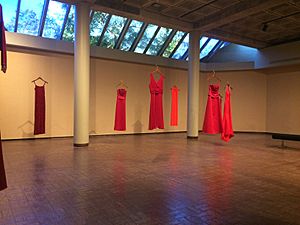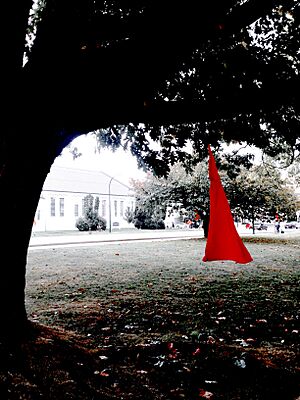REDress Project facts for kids
The REDress Project is a special art display created by artist Jaime Black. It uses empty red dresses to bring attention to the issue of missing and murdered Indigenous women (MMIW) in Canada and the United States. This important project started in 2010 and is still ongoing. It honors missing and harmed Indigenous women from First Nations, Inuit, and Métis communities in Canada, and Native American communities in the U.S. The project shows empty red dresses hanging in different places. The REDress Project has also inspired other artists to use the color red to highlight this issue. It even led to the creation of Red Dress Day.
Contents
Why the REDress Project Started
Jaime Black is a Métis artist. Métis people are an Indigenous group in Canada and the U.S. who have both Indigenous North American and European roots. Jaime Black was working at an art gallery in Winnipeg. She went to a conference in Germany where she heard about the many missing and harmed women in Canada. This made her want to do something to help.
Black suggested putting up a display of red dresses for a workshop at the University of Winnipeg. She said the idea of empty red dresses hanging outside came to her while listening to the speaker. The university liked her idea and helped her find the dresses.
So far, over 400 dresses have been given by women across Canada. Families of missing or harmed women have also given dresses. They have even attended some of the art displays.
What the Red Dresses Mean
Jaime Black chose the color red after talking with an Indigenous friend. Her friend told her that red is the only color spirits can see. Black explained that red is "a calling back of the spirits of these women." It allows them a chance to be with us and have their voices heard. She also said red connects to our "lifeblood" and means both life and strong feelings.
The dresses are empty on purpose. They remind us of the missing women who should be wearing them. Black said, "People notice there is a presence in the absence." This means even though the women are not there, their memory is strongly felt.
Some displays of the dresses have been indoors. But Jaime Black prefers to show them outdoors. When outside, the dresses move with nature. They catch the eye of people passing by. This helps introduce them to the issue of missing and harmed Indigenous women. Information signs are often placed nearby to explain more.
Where the Dresses Have Been Shown
The REDress Project has been displayed in over 30 places across Canada. Each display is a little different depending on the location. In 2019, it was shown for the first time in the United States.
Some important places where the dresses have been displayed include:
- March 2011: The very first display was at The University of Winnipeg.
- May 2011: It was shown at the Manitoba Legislature, a government building.
- October 2013: A whole floor of the Ecocentrix exhibition in London, England, was filled with the dresses.
- 2014: The Canadian Museum for Human Rights now has several dresses as a permanent part of its display.
- 4 October 2015: Jaime Black asked women across Canada to hang red dresses in their homes or public places. This was a way to show support on the National Day of Vigils for Missing and Murdered Aboriginal Women.
- March 2019: The National Museum of the American Indian in Washington D.C. displayed 35 dresses outside its building.
How the Project Has Inspired Others

In 2017, Tia Wood, a 17-year-old Cree jingle dancer, asked other dancers at a big event called the Gathering of Nations Powwow to wear red. They performed a special healing dance to honor missing and harmed Indigenous women. This "Red Dress Jingle Special" has been done at pow-wows ever since.
A Mi'kmaq woman named Sasha Doucette takes photos of red clothing in her hometown of Eskasoni First Nation. She first placed red dresses for women and red ribbon shirts for men at places where they were harmed. Now, she also does this for people who died in ways that could have been prevented.
In 2018, Isabella Aiukli Cornell, a member of the Choctaw Nation of Oklahoma, wore a special red dress to her junior prom. A Crow designer made the dress. She wore it to bring attention to the issues Indigenous women face. Cornell said, "The color red is symbolic of the Missing and Murdered Indigenous Women’s movement." She later gave her prom dress and shoes to the Smithsonian National Museum of American History.
The famous singer Buffy Sainte-Marie has also been inspired by the project. She often hangs a single red dress on stage at her concerts. In July 2019, Buffy Sainte-Marie, Tanya Tagaq, and Maxida Märak prominently displayed a single red dress on stage when they performed together.
Related Campaigns



